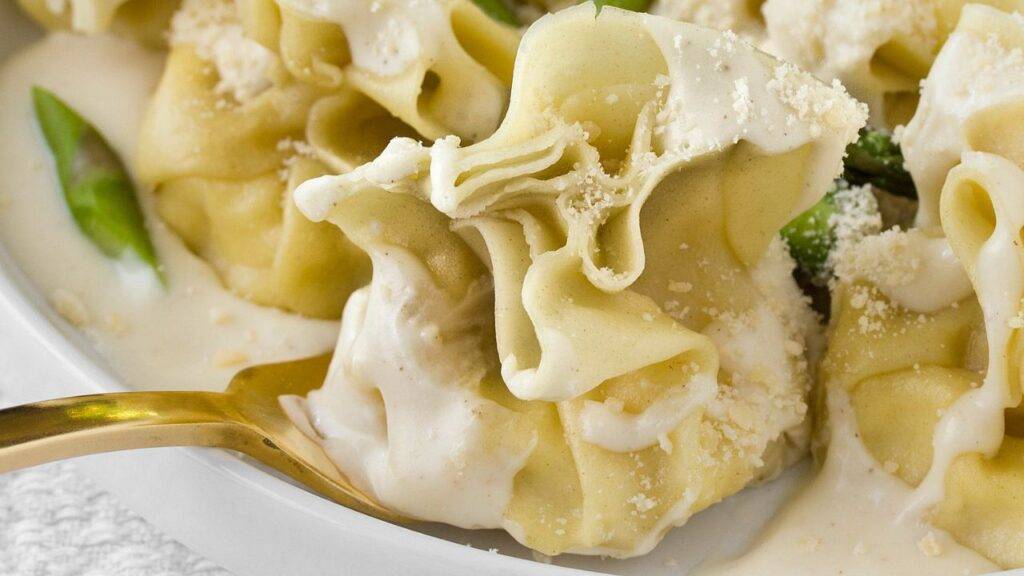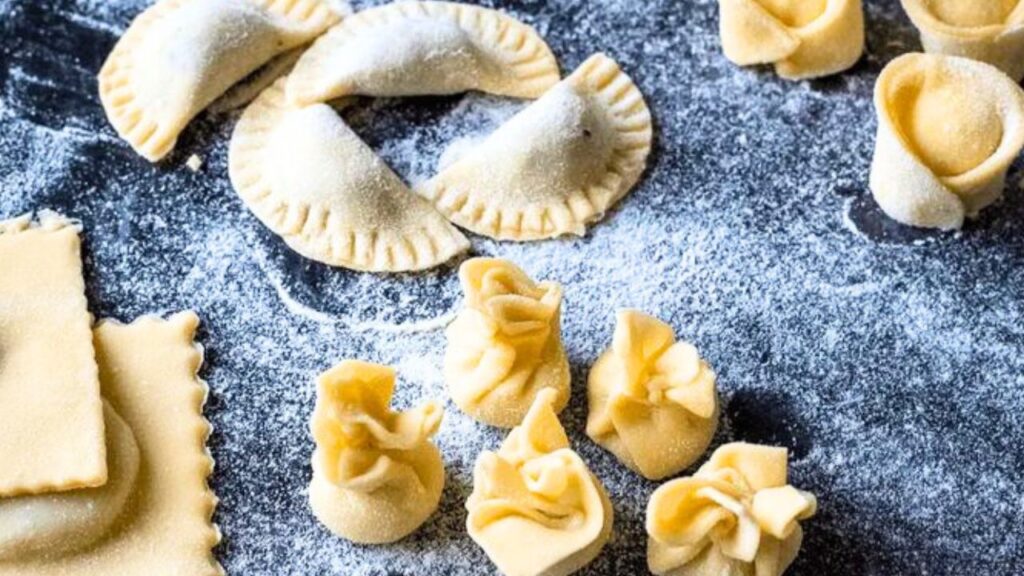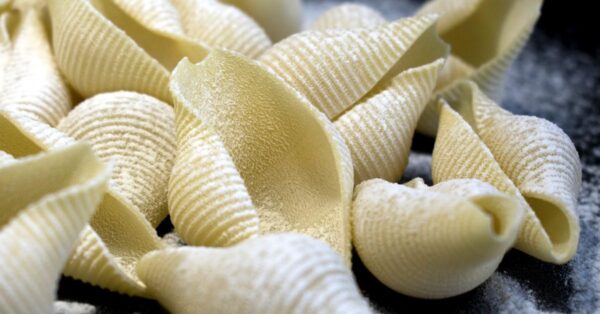Do you want the nice, soft comfort of a big Italian meal?
Enjoy the delicious tastes of sacchetti pasta recipe,
Sacchetti pasta is an integral part of Italian cuisine, with originated in the Emilia-Romagna region of Italy.
Located as the prime cooking center of Italy, this area has a long history of pasta-making traditions that have been carried over through the ages.
I’m offering an invitation to you to join me on a delicious experience that values the expertise and passion of Italian cooking.

Table of Content
- 1 How did I learn this dish?
- 2 Recipe
- 3 Method Instructions
- 4 More Recipes You May Like
- 5 Recipe Video
- 6 What to Pair with Sacchetti Pasta Recipe?
- 7 Servings
- 8 Tips
- 9 Ingredient Substitutes
- 10 Common Queries:
- 10.1 1. How does spaghetti cacio cotto taste?
- 10.2 2. How did sacchetti pasta come to be?
- 10.3 3. How should sacchetti pasta be kept?
- 10.4 4. What is pasta sacchetti?
- 10.5 5. Is the spaghetti sacchetti spicy?
- 10.6 6. Is it possible to prepare spaghetti at home?
- 10.7 7. Where can I get the sacchetti pasta ingredients?
- 10.8 8. Is it possible to alter the sacchetti pasta?
- 10.9 9. How long does it take to prepare pasta with sacchetti?
- 10.10 10. Can vegans or vegetarians consume spaghetti?
- 10.11 11. Can I prepare the sacchetti pasta in advance?
- 10.12 12. Why should you prepare this dish?
- 10.13 13. What is the best way to store leftover spaghetti?
- 10.14 14. What are some suggested entrées to pair with spaghetti squash?
- 11 Remarks
How did I learn this dish?
As a chef who is excited more learning about different food cultures from around the world,
I first became aware with what is sacchetti pasta when I visited to Italy and had the chance to experience the rich cooking traditions of how to make sacchetti.
I fell onto an ancient trattoria hidden in a cobblestone alley while wandering through the beautiful alleys of a small Italian village.
I had to give it their specialty dish after getting drawn in by the delicious scents coming from the kitchen.
Recipe
By our sacchetti pasta recipe, you may taste a delicious melody of spices where every little bag is a delicious gem just waiting to be found.
This delicious combination of unique creativity and classic Italian cuisine will transform your dining experience.
Ingradient
Cuisine: Italian
Category: Dishes
Prep Time: Approximately 1 hour
Cook Time: 3 minutes
Servings: 4
Calories: 200 calories
| 2 cups all-purpose flour |
| 3 large eggs |
| A pinch of salt |
| Filling of your choice (e.g., ricotta cheese, spinach, and herbs) |
Method Instructions
Let’s start with the sacchetti pasta recipe’s Method Instructions.
1. Wash Your Hands:
Make sure you give your hands a good wash before we start the experience of cooking. The foundation of healthy and secure cooking is having clean hands.
2. Prepare the Dough:
The pasta dough should be made first. Make a hole in the center of the mound of all-purpose flour that you made on a clean area.
Add a small teaspoon of salt and crack the eggs into the hole created.
Slowly mix the eggs into the flour with a fork until a dough forms.
3. Knead the dough:
After it comes together, knead it for five to seven minutes, or until it gets elastic and smooth.
This process aids in the development of the dough’s gluten, giving the pasta its ideal texture.
4. Rest the Dough:
Cover the dough with plastic wrap and leave it to rest for at least half an hour at room temperature after kneading.
This relaxes the gluten and helps roll out the dough.

5. Spread Out the Dough:
After letting the dough rest, divide it into smaller sections. Using a rolling pin or pasta maker, spread out each portion into thin sheets.
Aim for 1-2 mm (1/16 inch) of thickness.
6. Cut Out the Sacchetti:
After the dough sheets are rolled out, cut the dough into circles using a glass or a round cutter.
Put a tiny dollop of the filling of your choice in the middle of each round.
7. Shape the Sacchetti:
Fold the dough circle’s edges together to create a little pouch by gathering them around the filling.
Make sure the sides are completely sealed to stop any filling leakage while cooking.
8. Cook the Sacchetti:
Fill a big pot with boiling salted water. Slowly place the sacchetti into the boiling water and cook for around 3–4 minutes, or until they are cooked through and float to the top.
9. Serve and Enjoy:
Using a slotted spoon, take the cooked sacchetti out of the water and place them on serving plates.
Serve hot with your preferred sauce, and if you’d like, top with freshly chopped herbs and grated cheese.
Let’s now enjoy the delicious taste of homemade spaghetti cacio cotto!
More Recipes You May Like
- Smoked Sausage Recipes With Pasta
- Salpores de Arroz Recipe
- Authentic Pastalaya Recipe
- Beyond Jambalaya: Explore the Depths of Cajun Cuisine with Gumbo Recipe
- Shrimp Cargot Recipe
Recipe Video
Sacchetti Pasta Recipe
This is a video about Sacchetti Pasta Recipe.
Cradit: therhodeshow
Rated: 4.9 of 5.0 from 19 reviews.
What to Pair with Sacchetti Pasta Recipe?
I think Boursin Pasta Recipe with Chicken and Tomatoes is a great match for Sacchetti Pasta. The creamy Boursin sauce and juicy chicken blend perfectly with the unique texture of Sacchetti pasta.
Another tasty choice is creamy pasta and peas recipe for toddlers This creamy dish adds a nice contrast and pairs well with Sacchetti pasta for a delightful meal.
Servings
Let’s discuss some creative methods to present our sacchetti pasta:
- 1. Traditional Marinara Delight: Mix the sacchetti pasta in a thick marinara sauce consisting of garlic, herbs, and ripe tomatoes.
Add a dash of cheddar cheese on top for a traditional Italian flair. - 2. Creamy Alfredo Indulgence: To add a fancy twist, serve the sacchetti pasta with a Parmesan and garlic-infused creamy Italiano sauce.
Add some seafood or chicken to add even more protein. - 3. Pesto Paradise: Serve some fresh basil pesto sauce over some sacchetti pasta to celebrate the sunny tastes of summer.
For an addition of color and taste, garnish with cherry tomatoes and toasted pine nuts. - 4. Mushroom Madness: Use cream, sautéed mushrooms, and garlic to make a creamy and thick mushroom sauce for mushroom sacchetti.
For a delectable touch, toss the sacchetti pasta in the creamy mushroom sauce and garnish with chopped parsley. - 5. Zesty Lemon Herb: A spicy lemon herb sauce made with olive oil, fresh lemon juice, and chopped herbs like mint and basil may spice up the sacchetti pasta.
For an added taste boost, brush some lemon zest on top before serving. - 6. hot Arrabbiata Adventure: Serve the haitian hot pockets pasta with a smoky sauce made up of tomatoes, garlic, and hot red chili peppers for those who want a little spice.
Add some fresh basil leaves as a garnish for a refreshing contrast. - 7. Vegetarian Delight: Serve the sacchetti pasta with a mixture of roasted vegetables, such as cherry tomatoes, bell peppers, and zucchini, to keep it light and fresh. Brush some honey sauce over it to add a little sweetness.
- 8. Asian Fusion Twist: Try a tasty cook sauce made with soy sauce, ginger, and sesame oil to give the classic sacchetti pasta a new twist.
Chicken or prawn can be added to stir-fried vegetables to create a tasty Asian-inspired meal.
Your Sacchetti pasta will taste even better after using these inventive serving ideas!
Tips
The following are some useful tips for making more spicy sacchetti pasta:
1. Use fresh components:
To improve the taste and texture of your Sacchetti pasta, choose fresh, high-quality ingredients. The dish will taste much better with homemade sauces, fresh veggies, and herbs.
2. Prepare Ingredients in Advance:
To speed up the cooking process, prepare the pasta dough and filling early.
This saves you time and work by allowing you to quickly make the sacchetti when you’re ready to cook.
3. Season liberally:
Avoid holding back when adding seasoning!
For a tasty outcome, make sure to season the pasta dough, filling, and sauce components with salt, pepper, and your favorite herbs and spices.
4. Try Different Fillings:
Be creative while selecting your fillings!
You can customize your sacchetti pasta to your own tastes by playing with different combinations of veggies, cheeses, and proteins, even though classic fillings like ricotta cheese and spinach are great.
5. Keep Pasta Dough Moist:
When the pasta dough is not in use, cover it with a wet kitchen towel or plastic wrap to keep it from drying out while you make the sacchetti. This keeps it from breaking and preserves its flexibility.
6. Seal the Edges Properly:
To stop the filling from leaking as the pasta cooks, make sure the edges are sealed tightly. To create a tight seal, press the edges carefully with a fork or your fingers.
7. Cook al dente:
To make the sacchetti pasta solid to the bite, boil it in a big pot of salted water until it reaches an al dente state.
Take care not to overcook the pasta because it will lose its texture and become mushy.

8. Gently Toss:
For a smooth coating, mix the cooked sacchetti pasta in your preferred sauce.
To keep the weak pasta packages in their shape and prevent crushing, manage them carefully.
9. Garnish with Fresh Herbs:
To add some color and freshness, add some freshly cut parsley, basil, or chives over the sacchetti pasta before serving.
This gives the meal a bright final touch.
10. Serve Right Away:
Fresh, hot spaghetti is tastiest when it’s just off the burner.
For the best flavor and texture, serve right away after tossing with sauce and garnishing.
By using these ideas, you can make delicious and spicy Sacchetti pasta with ingredients that will wow both your family and guests.
Ingredient Substitutes
Here are some creative ideas to replace the ingredients in our recipe for Sacchetti pasta:
- 1. All-Purpose Flour: If you’re looking for a gluten-free option,
you can replace an equivalent amount of all-purpose flour with a blend of gluten-free flour, like chickpea or almond flour.
These substitutes will give the dough a comparable texture. - 2. Eggs: You can substitute a flax or chia egg in place of eggs to make the spaghetti dough vegan.
To make a flax or chia egg alternative, just combine 1 tablespoon of ground flaxseed or chia seeds with 3 tablespoons of water for each egg needed.
After allowing it to gel for a few minutes, continue with the recipe using it just like any other egg. - 3. Ricotta Cheese: You may use mashed tofu seasoned with nutritional yeast, garlic powder, and a mixture of herbs like basil and thyme as a dairy-free filling alternative to ricotta cheese.
The sacchetti will still have a great flavor and creamy texture with this substitute. - 4. Spinach and Herbs: You can use other leafy greens like kale, Swiss chard, or arugula in place of spinach if it’s not readily available or if you’d rather have a different flavor profile.
For a burst of fresh taste, you can also use a variety of finely chopped fresh herbs, such as oregano, basil, and parsley. - 5. Tomato Sauce: You may quickly prepare your own homemade tomato sauce by combining canned diced tomatoes, garlic, onion, olive oil, and a combination of Italian herbs like basil and oregano with store-bought sauce.
Use the mixture as a tasty topping for your sacchetti pasta after simmering it until it thickens. - 6. Chicken Broth: To make this a vegetarian or vegan option, use vegetable broth or water seasoned with a little soy sauce, miso paste, or dry herb powder for a flavor boost.
For a flavorful umami boost, you can also add seaweed or dried mushrooms to the soup. - 7. Parmesan Cheese: You may make a handmade vegan Parmesan cheese by blending cashews, nutritional yeast, garlic powder, and salt until crumbly, or you can use nutritional yeast flakes as a dairy-free substitute.
For a cheesy touch, generously sprinkle it over the fried sacchetti.
These flexible ingredient swaps give you the freedom to alter the Sacchetti pasta recipe according to your eating habits and the availability of ingredients, ensuring a tasty and delicious meal.
Common Queries:
1. How does spaghetti cacio cotto taste?
The taste of sacchetti pasta is deep and spicy, and the sauce perfectly balances its light and delicate structure.
2. How did sacchetti pasta come to be?
The word “sacchetti,” which translates to “little bags” in Italian, comes from the pasta’s native Italy,
where it is valued for having a shape similar to small pockets or purses.
3. How should sacchetti pasta be kept?
Cooked spaghetti can be kept in the fridge for three to four days if stored in an airtight container.
Alternately, for long-term storage, freeze raw sacchetti pasta on a baking sheet until solid, then move it to a freezer bag.
4. What is pasta sacchetti?
A type of packed pasta called sacchetti looks like small purses or pouches.
Usually served with a sauce, it is packed with delicious ingredients like cheese, meat, or veggies.
5. Is the spaghetti sacchetti spicy?
The filling and sauce that are used with sacchetti pasta define how spicy it is.
You can change it to suit your tastes by adding or removing the spicy components.
6. Is it possible to prepare spaghetti at home?
Yes
7. Where can I get the sacchetti pasta ingredients?
The ingredients for sacchetti pasta can be purchased online, at specialty Italian stores, or at your neighborhood grocery shop. Flour, eggs, cheese, veggies, and sauces are typical ingredients.
8. Is it possible to alter the sacchetti pasta?
Absolutely, you can alter the contents, sauces, and garnishes on sacchetti pasta to suit your own tastes.
Use your imagination when combining ingredients to create tasty and original combinations.
9. How long does it take to prepare pasta with sacchetti?
According to the recipe and technique, making sacchetti pasta takes different amounts of time.
Each step of preparing and cooking sacchetti pasta takes roughly one to two hours.
10. Can vegans or vegetarians consume spaghetti?
Vegetables, cheese, or tofu are examples of plant-based ingredients that can be used to make spaghetti squash vegetarian.
But if it has dairy or eggs in it, it may not be vegan-friendly.
11. Can I prepare the sacchetti pasta in advance?
It is possible to prepare the filling and pasta dough ahead of time, then mix and cook the sacchetti when it’s time to serve them.
12. Why should you prepare this dish?
You may impress your family and friends with a restaurant-caliber meal at home with homemade sacchetti pasta,
thanks to its superb taste and smart look.
13. What is the best way to store leftover spaghetti?
Remaining sacchetti pasta can be kept in the fridge for three to four days if stored in an airtight container. Before serving, reheat gently in the microwave or on the stovetop.
14. What are some suggested entrées to pair with spaghetti squash?
A number of side dishes, like salads, roasted vegetables, garlic bread, and light soups, go nicely with spaghetti. To create a well-balanced meal, select sides that improve the tastes of the pasta.
Remarks
Enjoy the beautiful, spicy taste of Sacchetti pasta, a delicious classic that delights the senses with every delicious bite.
This dish is sure to impress and satisfy all types of taste buds, so boost your dining experience.
2 thoughts on “Sacchetti Pasta Recipe”